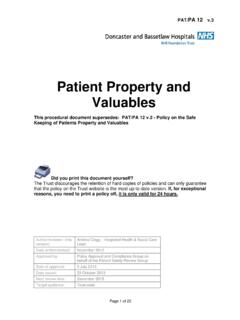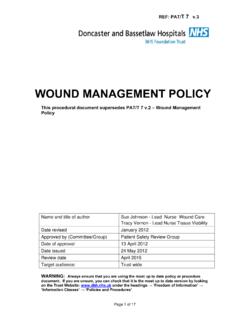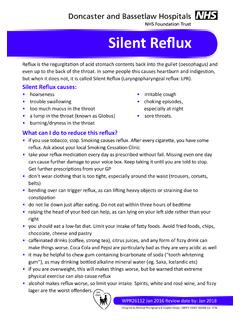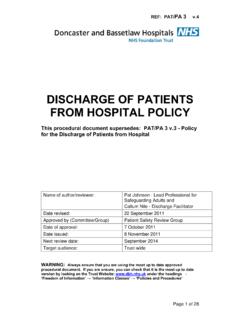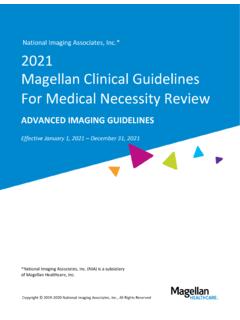Transcription of Guidelines for the Insertion and Management of Chest …
1 PAT/T 29 version 1 Page 1 of 14 Guidelines for the Insertion and Management of Chest Drains Name and title of author Laura Di Ciacca, Physiotherapy Clinical Head of Acute Services Dr Matt Neal, Consultant Anaesthetist Dr Martin Highcock, Consultant Physician Sr Michele Bruce, Senior Sister Sr Joanne Snowden, Respiratory Nurse Specialist Alison O Donnell, Clinical Procurement Specialist Date written/revised August 2007 Approved by (Committee/Group) Clinical Review Group Date of approval January 2008 Date issued January 2008 Review date January 2009 Discussed at Patient Safety Review Group 11 June 2012 - agreed to extend review date to December 2012 Target audience Trust wide WARNING: Always ensure that you are using the most up to date policy or procedure document. If you are unsure, you can check that it is the most up to date version by looking on the Trust Website: under the headings Freedom of Information Information Classes Policies and Procedure PAT/T 29 version 1 Page 2 of 14 Guidelines for the Insertion and Management of Chest Drains Table of Contents Page 1.
2 Aim/Objectives/Introduction/Responsibili ties 3 2. Indications for Use 4 3. Insertion /Technique 5 4. Training/Audit 9 5. Monitoring/Recording 10 6. Management of Chest drain and drainage system 11 7. Removal of the Chest drain 13 8. References 13 Appendix 1 Chest Drain Observation Chart - WPR 25720 PAT/T 29 version 1 Page 3 of 14 Guidelines for the Insertion and Management of Chest Drains 1.
3 Aim/Objectives/Introduction/Responsibili ties Aim To rationalise the use of Chest drains throughout the organisation and standardise the care of the adult patient with a Chest drain. Objectives 1. To identify the need for a Chest drain and select the appropriate drain and drainage system 2. To identify the safe Insertion and subsequent removal of a Chest drain 3. To ensure appropriate standardised documentation is used across the Trust 4. To identify appropriate training for all personnel involved in the Insertion / Management of Chest drains Introduction General Principles Chest drain must only be inserted by competent staff members. Ultrasound guided Chest drain Insertion is strongly advised for fluid. Signed consent must be obtained prior to the procedure where-ever possible. Out of hours avoid Chest drain Insertion for fluid if the patient is clinically stable. Chest drains are used in many different hospital settings and doctors in most specialties need to be capable of their safe Insertion .
4 Incorrect placement of a Chest drain can lead to significant morbidity and even mortality (NPSA 2008 / RRR03). These Guidelines are aimed at the Insertion and Management of Chest drains in the adult patient in a hospital environment. The scope of this guidance does not cover any other pleural procedures. A Chest drain is a tube inserted through the Chest wall between the ribs and into the pleural cavity to allow drainage of air (pneumothorax), blood (haemothorax), fluid (pleural effusion) or pus (empyema) out of the Chest . In any one patient it is essential to understand what the drain is aiming to achieve. The effective drainage of air, blood or fluid from the pleural space requires an adequately positioned drain and an airtight, one-way drainage system to maintain subatmospheric intrapleural pressure. This allows drainage of the pleural contents and re-expansion of the lung. In the case of a PAT/T 29 version 1 Page 4 of 14 pneumothorax or haemothorax this helps restore haemodynamic and respiratory stability by optimising ventilation/perfusion and minimising mediastinal shift.
5 Responsibilities It is the responsibility of each member of staff involved in the Insertion and Management of Chest drains:- - to comply with the standards set out in this guidance - to work within their own competence - to report all Chest drain issues (including near miss events) using the Trust s Incident Reporting procedures These issues should be discussed at relevant directorate Clinical Governance Groups and any identified actions resulting from incidents implemented. It is the responsibility of each member of staff and individual clinical departments to ensure they adhere to the training and audit requirements set out in Section 4 of this guidance. 2. Indications for Use Identification of the indication for a drain may be made by a combination of context (pathology, mechanism of injury), clinical examination and radiological imaging with more recently the use of bed side ultrasound examination.
6 The use of ultrasound-guided Insertion is strongly advised for pleural fluid (NPSA 2008, BTS 2010 Guideline) Following full clinical assessment, if there is any doubt, further imaging should be arranged. Pneumothorax Consider if Chest drain is required. Follow the BTS 2010 Algorithm 1. persistent or recurrent pneumothorax after simple aspiration 2. tension pneumothorax should always be treated with a Chest drain after initial relief with a small bore cannula or needle 3. in any ventilated patient with a pneumothorax as the positive airway pressure will force air into the pleural cavity and quickly produce a tension pneumothorax 4. large secondary spontaneous pneumothorax (>2cm) 5. iatrogenic Insertion of a central venous catheter. Not all will require drainage. Pleural fluid Malignant pleural effusion Simple pleural effusions in ventilated patients PAT/T 29 version 1 Page 5 of 14 Empyema and complicated parapneumonic pleural effusion Traumatic pneumothorax or haemopneumothorax Peri-operative eg.
7 Thoracotomy, oesophageal surgery, cardiothoracic surgery The urgency of Insertion will depend on the indication and degree of physiological derangement that is being caused by the substance to be drained. In general drainage for pleural fluid should be avoided out of hours. 3. Insertion of a Chest drain All personnel involved in the Insertion of Chest drains should be adequately trained and supervised. It has been shown that physicians trained in the method can safely perform the procedure with 3% early complications and 8% late (Collop,1997). With adequate training the risk of complications can be significantly reduced. Insertion of a Chest drain in a non-emergency situation will be a Consultant-led decision. It is the Consultant s responsibility to identify adequately trained doctors to perform the procedure. A trained nurse should be present to assist in the procedure. Insertion of a Chest drain in an emergency situation will be the responsibility of the most senior, experienced available member of staff.
8 Emergency insertions in trauma situations should follow ATLS (Advanced Trauma and Life Support) Guidelines Clinical assessment should take into consideration risk factors associated with Insertion of a Chest drain eg. clotting. Although there is no published evidence that abnormal blood clotting or platelet counts affect bleeding complications of Chest drain Insertion , it is good practice to correct any coagulopathy or platelet defect prior to drain Insertion . Before Insertion of the Chest drain Consent Written consent should be obtained whenever possible and documented as per Trust guidance. (PAT/PA 2 Policy for consent to examination or treatment) The identity of the patient should be checked and the site for Insertion of the Chest drain confirmed by reviewing the clinical signs and the radiological information. Aseptic technique All drains should be inserted with full aseptic precautions (washed hands, gloves, gown, antiseptic preparation for the Insertion site and adequate sterile field) in order to avoid wound site infection or secondary empyema.
9 PAT/T 29 version 1 Page 6 of 14 Patient position The patient should be positioned appropriately; this will depend on the reason for Insertion and the clinical state of the patient. The most commonly used position are either with the patient lying at 45 with their arm raised behind the head to expose the axillary area or in a forward lean position. The procedure may also be performed with the patient lying on their side with the affected side uppermost. In trauma situations emergency drain Insertion is more likely to be performed whilst the patient is still in supine position as part of the primary trauma survey. Premedication/local anaesthetic Chest drain Insertion has been reported to be a painful procedure with 50% of patients experiencing pain levels of 9-10 on a scale of 10 in one study (Luketich, 1998) therefore analgesia should be considered. Cleaning the skin with an antiseptic solution and adequate use of local infiltration of local anaesthetic (up to 3mg/kg of Lignocaine) allowing sufficient time to work is essential.
10 Use of other parenteral analgesics is useful but will not provide sufficient analgesia alone. If sedation techniques are being used, the procedure should be performed with appropriate monitoring and resuscitation equipment immediately available. Supplemental oxygen should also be considered (BMJ Career Focus 2004) The following potential complications should also be considered - incorrect placement (extrapleural, in the fissure, drainage holes outside the pleura, tube kinked) - injury to intercostals vessels - perforation of other vessels - pain (Laws et al, 2003) All equipment required to insert a Chest drain should be available before commencing the procedure. Chest drain tubes Chest drains come in a range of sizes suitable for a variety of purposes (typically 10-36Ch) and may be inserted via an open surgical incision (thoracostomy) or using the Seldinger technique incorporating a guide wire and dilator system.

